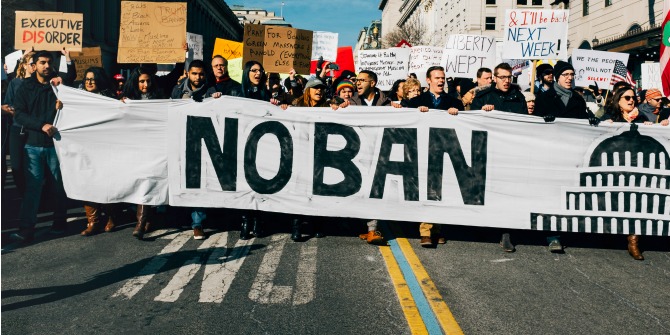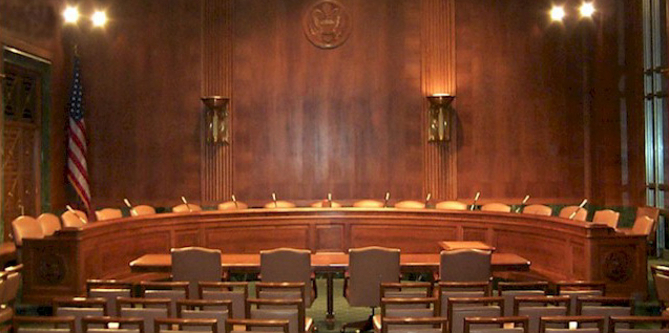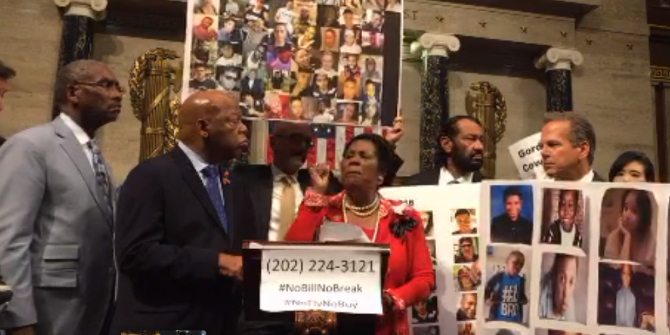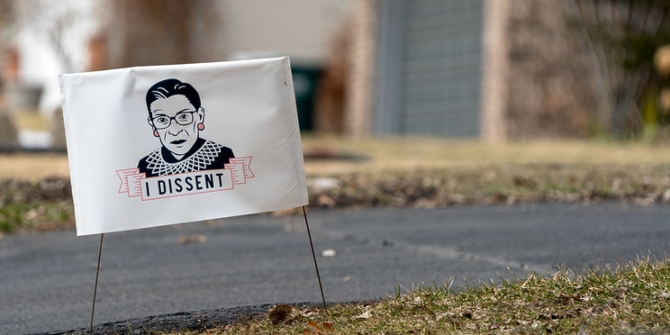 Many studies have found that prison inmates benefit from visits from their friends and families. Despite the benefits, which include a lower chance of recidivism, barriers to prison visits exist. In new research using Florida prison data, Joshua C. Cochran finds that these barriers are not distributed equally across all groups. He finds that Latino inmates, on average, are located much farther from their visitors than black or white inmates, and that black inmates are far less likely to be visited whilst in prison overall.
Many studies have found that prison inmates benefit from visits from their friends and families. Despite the benefits, which include a lower chance of recidivism, barriers to prison visits exist. In new research using Florida prison data, Joshua C. Cochran finds that these barriers are not distributed equally across all groups. He finds that Latino inmates, on average, are located much farther from their visitors than black or white inmates, and that black inmates are far less likely to be visited whilst in prison overall.
Studies suggest that there are many benefits or prison inmates from prison visits. Visitation has been linked, for example, to reductions in recidivism, reduced prison misconduct and disorder, and improved familial relationships post-release. Interviews with inmates and their family members suggest, too, that child visitation of incarcerated parents may be especially helpful for reducing some of the adverse impacts of parental imprisonment on children. However, in new research, my colleagues and I find that significant barriers to visitation exist, including travel distance and economic disadvantage, and that certain groups may have unequal access to visitation and its attendant benefits.
In theory, distance and economic disadvantage create a cascade of challenges for any given inmate’s potential visitors. For example, if one inmate is housed 50 miles from home and another is housed 250 miles, the latter inmate’s family and friends simply have more to overcome to make a visit possible. The 250-mile trip will incur greater transportation expenses, whether it is private or public transportation. The trip itself will also take more time and in turn it may require an overnight stay, more time off from work, and additional childcare, among other costs. For inmates and their families with more limited resources, these challenges will be exponentially worse. Taking a day off from work may be impossible, and affording transportation, hotel stays, childcare, and other expenses simply may be infeasible.
We sought to address several questions to better understand visitation challenges in our research. First, we wanted to understand how far away inmates are typically placed in a large state (Florida) and how this impacts visitation. Second, we wanted to know whether inmates from economically disadvantaged areas received fewer visits. Here, we make the assumption that at least a proportion of inmates’ visitors come from the same or similar areas as the inmate. And third, we assess whether coming from an economically disadvantaged area increases the adverse impact of distance from home on visitation likelihoods. That is, are visitors from poorer areas facing greater struggles overcoming long distances than are visitors from more affluent areas? We address these questions using data from an admissions cohort of Florida state prison inmates.
Figure 1 – Percentage of inmates visited by distance and race/ethnicity

Figure 1 above shows percentages of inmates visited at various placement distances. The identified pattern is as expected—longer distances reduced the probability of visitation, and inmates housed 350 miles or farther away are receiving almost no visitation. The plots are separated by race and ethnicity, because we also found important variation when comparing across white, black, and Latino inmates. In particular, and as you can see in the figure above, we found that blacks overall receive far fewer visits than whites and Latinos, regardless of distance.
We found that the average distance from home for any given inmate in Florida is 204 miles, but there are substantial differences when you separate by race and ethnicity. White inmates average about 195 miles, blacks average 206, but Latino inmates average 241 miles from home. If we operate under the assumption that 50 miles is equal to about an hour of travel time, this means that Latino inmates’ visitors must travel, on average, an hour farther away to visit the prison.
Figure 2 – County-level Heat Maps of Prison Capacity and Latino Inmate County of Origin
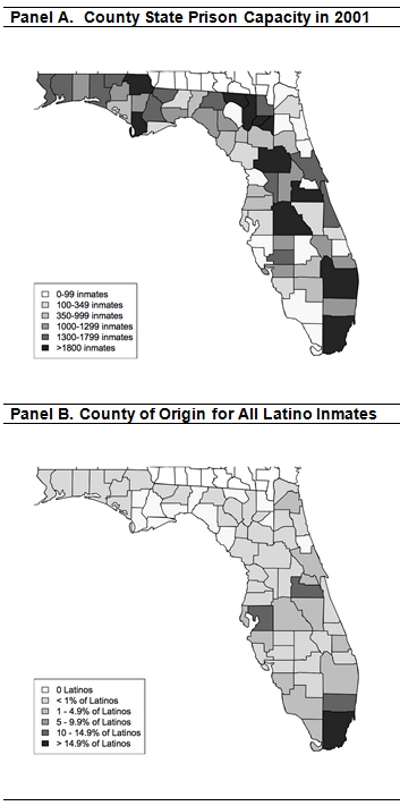
What explains this difference for Latinos in Florida? We think it might be due to an unintentional geographic situation. Panel A in the figure above shows that a large proportion of Latino inmates originate from south Florida (Miami-Dade county in particular). By contrast, panel B highlights that the largest capacity prisons are, for the most part, located in central and northern Florida. We think this may drive up the average distance for Latinos, compared to white and black populations which are not as clustered, and so are coming from counties more evenly spread across the state. This type of disparity in distance for specific subgroups may be a similar concern in other geographically large states with racial or ethnic clustering in regions.
Figure 3 – Predicted Likelihood of Visitation by Economic Disadvantage

Apart from distance, we find that economic disadvantage reduces the likelihood of visitation. However, as the figure above indicates, the likelihood of visitation for black inmates is lower than whites and Latinos, and appears to be unaffected by disadvantage. We are not sure why the likelihood of visitation is so consistently low for blacks, or why disadvantage yields no effects, but we suspect a number of factors may be at play, including the possibility that black inmates come from overall more disadvantaged contexts compared to whites and Latinos, which would make rates of visitation for blacks quite low and would make it difficult to identify any relative variation in visitation likelihoods among blacks.
Several other important findings emerged in our study. One of which is that we do identify important “interaction” effects between distance and disadvantage for black inmates. Specifically, we found that black inmates from the most disadvantaged communities are also most adversely impacted by longer placement distances. For example, we found that moving from 25 miles away to 100 miles away reduced the estimated likelihood of visitation by 15 percentage points for black inmates from the most disadvantaged black communities, compared to only a 5 point reduction for black inmates from the most affluent black communities. We did not identify similar effects for whites or Latinos.
Taken together, these findings hold important insights for understanding better the effects of incarceration and prison experiences, and for shedding light on additional pathways through which certain inmate subgroups—like poor and minority inmates—may be especially disadvantaged by incarceration. Here we find that significant barriers to visitation exist, and that these barriers may more adversely impact black and Latino inmates for different reasons. If visitation is indeed beneficial, as a number of studies suggest, this means that a range of barriers are reducing access to these potential benefits, and may be doing so unequally across prison populations.
This article is based on the paper “Spatial Distance, Community Disadvantage, and Racial and Ethnic Variation in Prison Inmate Access to Social Ties,” by Joshua C. Cochran, Daniel P. Mears, William D. Bales, and Eric A. Stewart, published in the Journal of Research in Crime and Delinquency.
Featured image credit: Chris Frewin (CC-BY-NC-ND-2.0)
Please read our comments policy before commenting.
Note: This article gives the views of the author, and not the position of USAPP – American Politics and Policy, nor of the London School of Economics.
Shortened URL for this post: http://bit.ly/1j33EqP
_________________________________
 Joshua C. Cochran – University of South Florida
Joshua C. Cochran – University of South Florida
Joshua C. Cochran, Ph.D. (email: jccochran@usf.edu) is Assistant Professor in Criminology at the University of South Florida, and studies punishment, sentencing, and theories of crime. He was recently awarded the American Society of Criminology’s Division on Corrections and Sentencing Dissertation Award for his doctoral thesis focused on imprisonment and the implications of inmate social ties. Cochran is the author, with Daniel P. Mears, of Prisoner Reentry in the Era of Mass Incarceration (Sage Publications). You can follow him on Twitter: @JoshuaCCochran.


